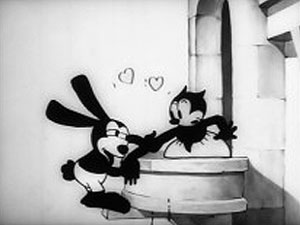 The early silent Walt Disney cartoon Oh, What a Lucky Knight (1928) shows Oswald the Lucky Rabbit riding along on a donkey playing an accordion, a very lively scene with musical notations flying out of his instrument which was the silent era's method of indicating sound.
The early silent Walt Disney cartoon Oh, What a Lucky Knight (1928) shows Oswald the Lucky Rabbit riding along on a donkey playing an accordion, a very lively scene with musical notations flying out of his instrument which was the silent era's method of indicating sound.
At a silent film house, any organist worth his salt would've provided actual music, with the organ set to sound like an accordion or concertina. A version posted at youtube by some witty fellow going by Hya Powa has added an actual tune, a speeded up version of "Ain't Gonna Rain No More," which is surprisingly effective, & has given the entire film a soundtrack better than the ones Walter Lantz added to some reissued silent Oswalds.
The gleeful donkey dances to the tune, miraculously not shaking Oswald off his back. But eventually the donkey stumbles & falls down a hillside upside-down, Oswald riding on his belly as upon a sled.
They land in an swamp, wherein an alligator manages to eat the donkey's tail, then laughs at the donkey who is distraught to have his tail docked. Fortunately he's able to pull on his own stub & stretch it out to its original length.
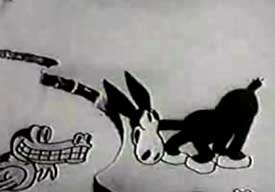 Oswald meanwhile comes to a castle surrounded by a moat. These early cartoons really didn't care about continuity or if one scene failed to lead rationally into the next. You have to give it rather too much thought to realize the alligator swamp was actually a castle moat. Oswald meanwhile comes to a castle surrounded by a moat. These early cartoons really didn't care about continuity or if one scene failed to lead rationally into the next. You have to give it rather too much thought to realize the alligator swamp was actually a castle moat.
Musical notations issue from his mouth as he whistles up to the balcony for his girlfriend, a cat. She blows him a kiss in quite an amusing manner & his pants fall down. Oswald tries to serenade her but his accordion is full of water. The donkey arrives, laughing at Oswald's failed attempts at music, but then helps him climb to the balcony where Oswald stretches out the kitty's arm kissing along the absurd length.
The bear-like villain Pete turns out to have the kitty trapped in the castle tower. When Oswald gets inside the tower, he finds his girlfriend chained to an iron ball. Pete is after him in full armor, armed with pike. Oswald has no armor or weapon, but he finds a sword leaning up against the wall.
A duel ensues, with Oswald's shadow sharp against the wall. Eventually Oswald gives the sword to his shadow, which remains behind to continue the duel as Oswald goes to greet his kitty girlfriend, who seems very happy though still chained up.
More duelling antics procede, Oswald rushing to the kitty to get kisses between moments of action. Eventually he gets the iron ball off the kitty's leg. Pete is joined by some robotic toy soldiers but Oswald uses the iron ball to knock them down like bowling pins. He then spits a big black wad of spit at Pete which kills him.
As Oswald & Kitty try to leave by the door, they discover a lion guards the other side, & so they leap out the balconied window toward the moat.
Oh, What a Lucky Knight is rather primitive & by the time Walt set out on his own & created Steamboat Willie (1928), he was so steeped in Oswald for Universal that "Willy" (afterward Mickey Mouse) is pretty obviously Oswald with round ears. Oswald himself as designed by Walt & Ub Uwerks was really only Felix the Cat with lengthened ears.
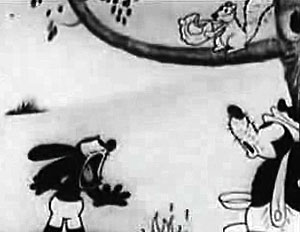 Oswald the Lucky Rabbit stars in Weary Willies (1929), a name dating to the Victorian age for a hobo. There were Wearie Willies in the newspaper funnies, on the vaudeville stage, & in Edison comedy films among the earliest silent films (see for example Weary Willie Kisses the Bride, 1904).
Oswald the Lucky Rabbit stars in Weary Willies (1929), a name dating to the Victorian age for a hobo. There were Wearie Willies in the newspaper funnies, on the vaudeville stage, & in Edison comedy films among the earliest silent films (see for example Weary Willie Kisses the Bride, 1904).
Weary Willies was an early sound cartoon though the soundtrack for it does not survive. Still under the influence of the silent era, however, nothing that happens required sound anyway.
A very primitive drawing of a train is shown barrelling down the tracks. It stops & out steps a tramp, Oswald the Lucky Rabbit. A "bull" or train cop, played by a bulldog, tries to catch the rabbity weary willie, eventually shooting him in the butt.
Oswald meets Peg Leg Pete the bear at a hobo camp. Pete's often a villain, but they welcome one another as pals. Pete shares his coffee, & Oswald shares his one egg. Oswald gets angry trying to stop Pete from "flipping" the egg in a pan, afraid it's going to fall in the fire. Instead, a squirrel on a limb above their heads grabs it.
Pete smells a roast turkey on a window sill cooling. He lays a plan which Oswald doesn't want to participate in, until Pete threatens him. The plan is for Oswald to steal the turkey & bring it to Pete.
In a bit of macabre humor, a guard dog rips off Oswald's skin leaving him in his longjohns. Oswald paces half naked, wondering what to do, when he realizes his own shadow would make a nice new skin.
With the aid of another pair of longjohns which comes to life on the clothesline, Oswald finally gets the turkey, but the buldog bull from the trainyard is quickly after him. He flees to the hobo camp & leaves the turkey in Pete's hands.
Soon both weary willies are fleeing down the road, neither having had a thing to eat. Oswald & Pete are also hobo companions in Hungry Hoboes (1928).
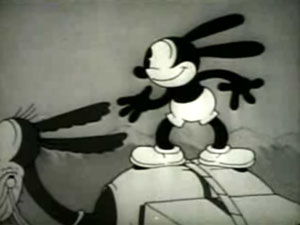 M any of the early series-cartoons characters got round to visiting Alaska at one time or another, & Oswald the Lucky Rabbit has just such adventures in Alaska (1930).
M any of the early series-cartoons characters got round to visiting Alaska at one time or another, & Oswald the Lucky Rabbit has just such adventures in Alaska (1930).
He's a sourdough riding on a donkey, with a pack of miner's gear. Oswald says, "There's gold in them thar hills!" & a mountain peak smiles with gold fillings in his teeth, replying, "You said a mouth full!"
Oswald has an old man sort of voice, the same voice that sings Oswald's theme song behind the opening credits, & a couple more verses in the cartoon itself. This is not his usual voice.
Several sight gags with the donkey bring Oswald to a frontier town & into a saloon crowded with animal-people & a number of musicians such as a goat banjoist, dog pianist, & Oswald gets a harmonica.
Everyone dances, & a sad-looking dog sings "A Boy's Best Friend is His Mother," but with funnier words, accompanied by a huge dog with a tiny fiddle.
The saloon is just packed with great characters. A fly hums with its wings the tune to "Shoo-fly Don't Bother Me" which Oswald sings. The shoofly harasses a sleepy pig & gets squished. Three beer bottles tapdance along a shelf.
Oswald joins a peg-leg bear (doubtless the often villainous Pete but he's not villainous here) & together they sing "Pop Goes the Weasel." Oh, it's such a fun saloon, with many other whimsical charactesr & gags.
copyright © by Paghat the Ratgirl
|
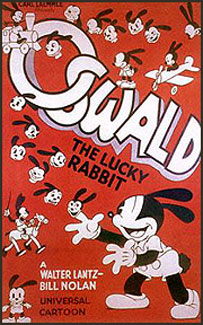
 The early silent Walt Disney cartoon Oh, What a Lucky Knight (1928) shows Oswald the Lucky Rabbit riding along on a donkey playing an accordion, a very lively scene with musical notations flying out of his instrument which was the silent era's method of indicating sound.
The early silent Walt Disney cartoon Oh, What a Lucky Knight (1928) shows Oswald the Lucky Rabbit riding along on a donkey playing an accordion, a very lively scene with musical notations flying out of his instrument which was the silent era's method of indicating sound. Oswald meanwhile comes to a castle surrounded by a moat. These early cartoons really didn't care about continuity or if one scene failed to lead rationally into the next. You have to give it rather too much thought to realize the alligator swamp was actually a castle moat.
Oswald meanwhile comes to a castle surrounded by a moat. These early cartoons really didn't care about continuity or if one scene failed to lead rationally into the next. You have to give it rather too much thought to realize the alligator swamp was actually a castle moat.
